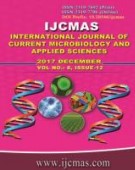


 National Academy of Agricultural Sciences (NAAS)
National Academy of Agricultural Sciences (NAAS)

|
PRINT ISSN : 2319-7692
Online ISSN : 2319-7706 Issues : 12 per year Publisher : Excellent Publishers Email : editorijcmas@gmail.com / submit@ijcmas.com Editor-in-chief: Dr.M.Prakash Index Copernicus ICV 2018: 95.39 NAAS RATING 2020: 5.38 |
Rice is a staple food crop for more than 50% of world’s population. The success of green revolution that began in 1960’s led to a tenfold increase in rice yield but it is clear now, that the gains from the grains of the previous green revolution have exhausted. By 2050 there would be 1309 million tonnes demand of rice and C3 rice even when best managed can yield only 915 million tones. Increasing radiation use efficiency (RUE), water use efficiency (WUE) and nutrient use efficiency (NUE) are the contemporary approaches being tested on a wider scale. C4 type photosynthesis due to its carbon dioxide tunneling system and negligible photorespiration is much more efficient than the C3 system even at tropical temperatures where rice is generally grown. Even though engineering C4 rice requires syndromic large scale tweaking in physiology, advances in genome wide deep sequencing and genome editing platforms have brought the possibility of making C4 rice closer than ever before. A selected group of C4 genes have been inserted into rice through mutagenesis and hybridization and their effects recorded in transgenics upto 3 generations. The compartmentalized overexpression of key C4 genes using Rice DNA activation tagging constitutes another approach towards C4 rice. Since C4 plants have evolved independently multiple times from C3 origins, it is being investigated whether the key genes and gene regulatory networks that regulate C4 plants have been recruited from C3 ancestors. To facilitate this, comparative transcriptomes analysis of C3 vs. C4 leaves and other C3 and C4 tissues has been done and thus the exact number of genes differentially expressing between C3 and C4 can now be calculated. The high throughput OMIC data thus generated is cross referenced with whole genome databases and this has yielded sufficient number of candidate genes for bundle sheath specific expression. Fox hunting systems and Tos 17 transposable systems have also yielded a set of interesting mutants in this regard. Identification of mutants through DHPLC and TILLING are used to track down whole genome duplication events in the evolution towards C4 rice. While the discovery of cis acting sequences in C3 to C4 transition is a favorable advance, our further studies are limited by the poor resolution of transcript profiles and epigenetic signatures. Availability of only a few models of in silico studies about performance of C4 rice under dense crop canopies is another limitation.
 |
 |
 |
 |
 |